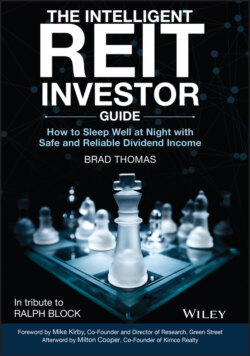Читать книгу The Intelligent REIT Investor Guide - Brad Thomas - Страница 29
CHAPTER 3 REITs over the Decades
Оглавление“Investing isn't about beating others at their game. It's about controlling yourself at your own game.”
—Benjamin Graham
As we discussed briefly in Chapter 2, few assets are more illiquid than commercial real estate such as office buildings, shopping centers, apartments, and the like. They're also very expensive to own and operate, which made them a “boom and bust” business in the past. Fueled by unreliable information (or at least a serious lack of good information), fortunes could be lost on these purchases.
Then again, fortunes could also be made – provided one already had a small fortune to begin with. Commercial real estate was the quintessential “you've got to have money to make money” example before the mid‐twentieth century. It was a wealthy man's game until REITs came along.
The concept was really spawned by a real estate management company in Boston, Massachusetts, that used a business trust vehicle to avoid paying double taxes on its holdings. It was ultimately taken to court over this, with the court's decision basically boiling down to “if it walks like a duck and acts like a duck, it's probably a duck.” And so ended the earliest REIT ancestor.
Yet that defeat prompted a new battle as the same company hired a law firm – Goodwin Proctor – to design a vehicle that would be legally acceptable. This time, it met with success. Congress accepted the accurate argument that small investors were unable to benefit from commercial real estate investing. As such, it agreed to allow a new business classification using mutual fund rules as a model.
(Interestingly, that's why REITs originally had to involve outside property managers: because the company that created them was precisely that. Self‐interest, right? It's a beautiful thing.)
REITs were officially defined and authorized by Congress in the Real Estate Investment Trust Act of 1960, and the first actual examples were organized that same year under the following understanding:
1 A REIT must distribute at least 90% of its annual taxable income, except for capital gains, as dividends to its shareholders (most pay out 100%).
2 A REIT must have at least 75% of its assets invested in real estate, mortgage loans, shares in other REITs, cash, or government securities.
3 A REIT must derive at least 75% of its gross income from rents, mortgage interest, or gains from the sale of real property. And at least 95% must come from these sources, together with dividends, interest, and gains from securities sales.
4 A REIT must have at least 100 shareholders with less than 50% percent of the outstanding shares concentrated in the hands of five or less shareholders.
The concept was pretty popular right out of the gate. Some of the earliest to go public were Washington, Pennsylvania, and Bradley REITs (the latter of which was not named after me) – small companies for small investors who only wanted to buy up 10, 100, or 1,000 shares. A large number of other equity REITs queued up for their IPO (initial public offering) spotlights as well. But the assassination of President John F. Kennedy in 1963 threw the markets into turmoil, permanently pushing most of those debuts back.
It was a major setback to the sector's early evolution.
According to The REIT Investment Summary, a 1996 report published by Goldman Sachs, there were really only 10 of these businesses worth noting in that first decade. The companies in question ran portfolios worth $11 million to $44 million, and many of them were attached to management companies that were affiliated with members of their boards. It goes without saying that this could and did too easily create issues.
Even so, they did manage to perform well enough, thanks in part to the real estate market at the time. Cash flow (the original stand‐in for the to‐be‐explained funds from operations, or FFO) grew an annual average of 5.8%, with 6.1% average dividend yields. All told, they easily returned more than the S&P 500 between 1963 and 1970 (11.5% versus 6.7%).
